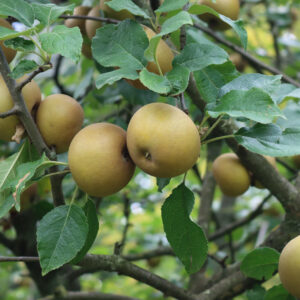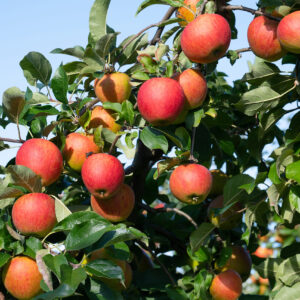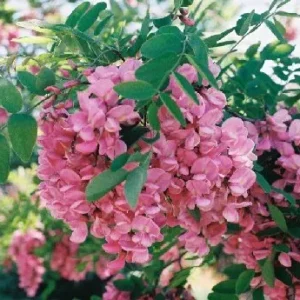I never weighed any pigs at the beginning and close of the mulberry season, but think I can safely say that a pig weighing 100 pounds at the start would weigh 200 pounds at the close. … Three-fourths to the mulberries is safe calculation of the gain. I have had the patch about 18 years bearing. I planted my trees just 32 feet apart, and now the branches are meeting, and I have about 40 trees. I have carried 30 head of hogs through from May 1 to August 1, with no food but the gleanings of the barn and what slops came from the kitchen of a small family.
James C. Moore, farmer of Auburn, Alabama as reported by J. Russell Smith in Tree Crops
From all accounts, mulberries seem like a top-notch hog feed. Almost all fruits are going to offer ample feed energy, and mulberry can certainly do that, but I have also gathered that mulberry might have a higher protein content than most fruits, which would be very valuable for feeding monogastric livestock. So I went down a deep internet rabbit hole, trying to figure out the feed value of mulberry fruit and, to a lesser extent, mulberry leaves. Mulberry leaves have been studied more thoroughly for use as livestock feed and are widely regarded as a high quality feed that is high in protein and easily digestible with significant value for monogastrics and ruminants. What I hadn’t learned much about was the feed value of the fruits, but those are likely the most promising feature of mulberries for monogastric, livestock-harvested silvopasture systems where animals freely pick up fruit from the ground without human labor.
With so little current research on mulberry fruit, and certainly not for use in silvopasture systems, I needed to put a bunch of pieces together. So here’s a summary of what I found.
Mulberry fruits have a really wide range of protein levels, depending on the tree and what studies you look at. One particular trial (which we’ll look at later) showed crude protein levels as low as 5.5%, while another study showed levels of 11.5-18.5%, with one outlier sample even at a whopping 28.7% protein as a percentage of dry matter. While this wide range of results is initially frustrating if looking for a clear answer to the question “how much protein do mulberry fruits have”, this variability makes sense because of the normal variation of data sets driven by context and selections. Even in crops with as much breeding work as field corn there can be a wide range of protein levels. Similarly, honey locust pods can have anywhere from 15% to 40% sugar, and even more if it’s a seedless pod, which increases the proportion of sugar to the total pod weight. With mulberries, the protein is almost certainly concentrated in the seeds, so if a tree isn’t getting pollinated or pollinated poorly, it may still yield fruit, but with low protein content. This wide variation in protein content means there’s likely a lot of selecting work to do for high-protein cultivars, as well as a need to integrate male trees when protein production is desired. Furthermore, there are certainly other variables to understand and manipulate, including soil fertility, soil biology, seasonality and more.
| Cultivar | Species | % Dry Matter | %Protein fresh | %Protein on Dry Matter Basis |
| Zhongsang | Morus atropurpurea | 12.80% | 1.62% | 12.7% |
| Dashi | Morus atropurpurea | 16.40% | 4.71% | 28.7% |
| Guang 7200 | Morus atropurpurea | 12.60% | 2.30% | 18.3% |
| Jushensang | Morus atropurpurea | 14.70% | 1.87% | 12.7% |
| Damo | Morus multicaulis | 17.40% | 2.41% | 13.9% |
| Hong. | Morus multicaulis | 19.40% | 2.24% | 11.5% |
| Yaan | Morus cathayana | 30.00% | 5.54% | 18.5% |
| Lvshenzi | Morus alba | 21.10% | 2.99% | 14.2% |
From the limited research I was able to find, mulberry fruits also have a solid amino acid profile for use as feed. Amino acids are the building blocks of protein, but amino acids concentrations vary from protein to protein. The essential amino acids are more valuable in feed as they c In the words of one paper “In our results, the Essential Amino Acid / Total Amino Acid ratio of both the Russian mulberry and the white mulberry fruits were close to or above [eggs, milk and fish], suggesting that the two kinds of mulberry fruits described here could be used as a high quality protein source.” I recorded the numbers from various key amino acids below, with the middle column showing the fresh amino acid concentration, and the right column showing the concentration on a dry matter basis (DMB).
| Morus alba (22%DM) | % DMB | |
| Lysine | 0.11% | 0.50% |
| Methionine | 0.08% | 0.36% |
| Threonine | 0.16% | 0.73% |
| Tryptophan | 0.009% | 0.04% |
| Total Protein | 1.22% | 5.55% |
| Morus alba tatarica (27% DM) | %DMB | |
| Lysine | 0.13% | 0.48% |
| Methionine | 0.142% | 0.53% |
| Threonine | 0.22% | 0.81% |
| Tryptophan | 0.023% | 0.09% |
| Total Protein | 2.25% | 8.33% |
Jiang, Y., & Nie, W.-J. (2015). Chemical properties in fruits of mulberry species from the Xinjiang province of China. Food Chemistry, 174, 460–466.doi:10.1016/j.foodchem.2014.11.083
Below are results from a study on the amino acid profile of mulberry leaves. Note that numbers are given in mg/g DM, so values in the “Content” column should be divided by 10 to achieve a percentage value.
Now let’s put these data together in context so that we can see the significance of these numbers for feeding pigs. Below is a chart comparing the results of the mulberry fruit and leaves above with the values for corn, as well as the nutritional needs for pigs at various life stages. The data for corn protein and protein needs for pigs come from the book Happy Pigs Taste Better (pages 217-221).
| % Protein of mulberry fruits, mulberry leaves, and corn | % Protein requirements for various pig stages | ||||||
| M alba t. | M alba | M leaves | Corn | Early Finisher | Late Finisher | Gestating Sow | |
| Lysine | 0.48 | 0.50 | 1.23 | .29 | .73 | .57 | .51 |
| Methionine | 0.53 | 0.36 | .30 | .19 | .20 | .16 | .14 |
| Threonine | 0.81 | 0.73 | 1.05 | .33 | .48 | .38 | .51 |
| Tryptophan | 0.09 | 0.04 | .74 | .07 | .13 | .11 | .10 |
| Total Protein | 8.33 | 5.55 | 20.4 | 9.3 | 17.2 | 14.7 | 13.78 |
Note that the mulberry fruits have significantly higher essential amino acids in almost every category as compared to corn. Another important consideration is that these are numbers from mulberry samples that tested significantly below the first cited study in terms of total protein content. That study showed a range of 11.5% to 28.7% crude protein. Meanwhile it follows that mulberries with 2-3 times the crude protein should yield significantly higher essential amino acids as well.

To back these studies up with some more benchmarks, consider the nutritional content labels of a few mulberry products meant for human use. For fresh mulberries with 88% water and hence 12% solids, this product has 1.4g of protein, which translates to 11.7% protein on a dry matter basis. This website indicates 4.2g of protein per 100g of product, of which about 81% is dry matter, yielding us about 5.2% protein on a dry matter basis. Lastly, this website gives values for Morus rubra, indicating 1.44g of protein per 12g of dry matter, yielding 12% protein DMB.
A couple takeaways:
- We should have more research comparing crude protein and amino acids for fruit from various cultivars, and with the same cultivars in different conditions, to give us a much better understanding of the nutritional content of mulberry fruits in different contexts. I plan to take samples from our trees this upcoming season and have them analyzed for protein and amino acids, and will share those results in an update.
- I could not find data for amino acid digestibility for fruit, which would be very useful to have.
- Already it looks like mulberry can be at or above the levels of protein provided by corn, with thus the ability to offset a very significant amount of feed costs for farmers, especially given the ability to yield heavily. (See my previous article for estimates of yield and value of production. A quick estimate is that you might be able to see $2,000+ of feed savings per acre, per year).
- Not only are mulberry leaves high in crude protein, they also exceed nutritional requirements for many amino acids for most pig life stages, thus forming a great nutritional supplement to mulberry fruits, as well as to corn or other grains.
- Farmers establishing mulberries in pastures should consider adding male trees for pollination purposes to increase the protein content of fruits. Male trees can be used for both pollination and providing additional leaf fodder.
- A high protein content of the fruit makes more sense of statements found in J. Russell Smith’s book Tree Crops, that farmers throughout the South would provide little to no feed supplement during mulberry season.

Here is Smith citing three farmers (pages 100-101)
The everbearing varieties will continue to bear from early May to late July, a period of nearly three months. I believe that a single tree would support two hogs weighing 100 pounds each and keep them in a thrifty condition for the time that they are producing fruit. They could be planted about 35 trees to the acre.
Professor J.C.C. Price, Horticulturist, Agricultural and Mechanical College, Mississippi (quoted from Tree Crops)
I only have a few trees, but they are large ones, 100 feet apart. … I would not take $25 per tree for the old trees. I have three hogs to the tree. They are doing fine, in good flesh. … I have not weighed any hogs that were fed on mulberries, but estimate that they gained one pound and over per day. My hogs have a feed of two small ears of corn twice a day.
F.A. Cochran, breeder of Berkshire swine at Derita, North Carolina (quoted in Tree Crops)
J.C. Calhoun, farmer of Ruston, Louisiana, said:
The variety is the “Hicks.” I set them out 30 x 30 feet apart. I have 50 trees. They were mere switches when I set them out about three feet high. They began bearing the second year and made rapid growth. The fourth year after putting them out the trees would nearly touch, and they are abundant bearers—ripening from the last of April to the last of July. There is nothing that a hog seems to enjoy better than mulberries. I always feed my hogs at least once a day, but I find that it takes considerable less feed for them to thrive and do well during mulberry season.
J.C. Calhoun, farmer of Ruston, Louisiana (quoted in Tree Crops)
While more research is certainly in order, this information shows tremendous value in mulberry fruit, along with ample reason for anyone raising pigs or poultry on pasture to start planting trees for their livestock to reduce their feed bills and kick their dependence on costly external inputs. We can imagine a future where perennial, grass-based farms produce their own feed, not only for cattle and sheep but also for hogs and poultry. Not only can we imagine it, but we have the tools to make it happen.
Bibliography
https://sci-hub.se/https://doi.org/10.1016/j.foodchem.2014.11.083
https://www.ncbi.nlm.nih.gov/pmc/articles/PMC3466457/
https://sci-hub.se/https://doi.org/10.1016/j.foodchem.2014.11.083
https://www.healthline.com/nutrition/foods/mulberries#nutrition
https://www.healthysupplies.co.uk/white-mulberries-100g-samarkand.html
https://www.fruitsinfo.com/red-mulberry.php
J. Russell Smith. (2019). Tree Crops. The Devin-Adair Company. (Original work published 1953)
Percy, Alice. Happy Pigs Taste Better: A Complete Guide to Organic and Humane Pasture-Based Pork Production. Chelsea Green Publishing, 2019.




